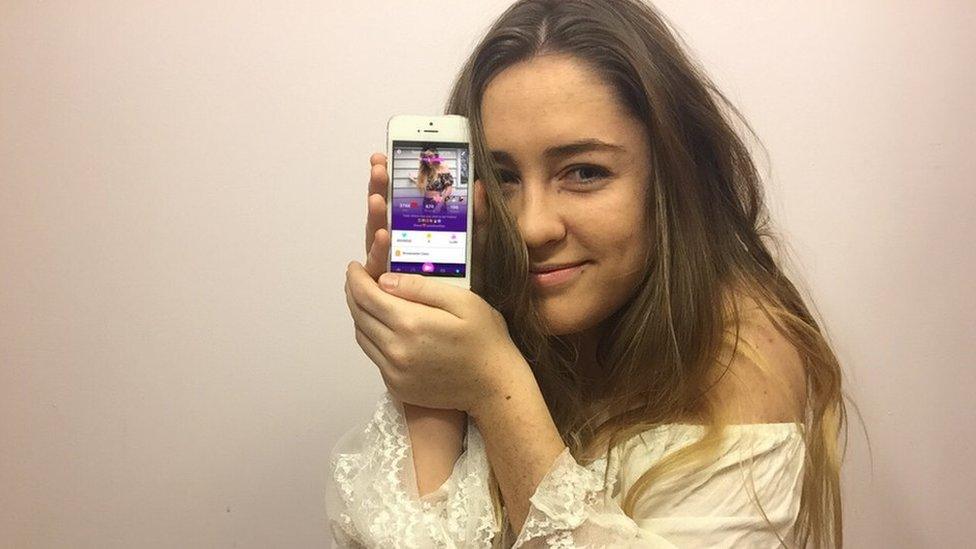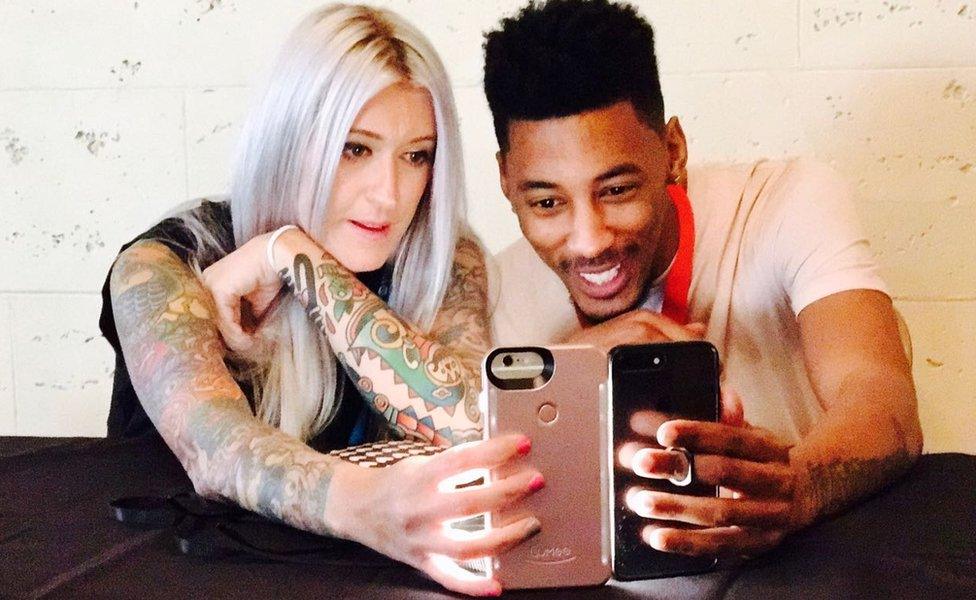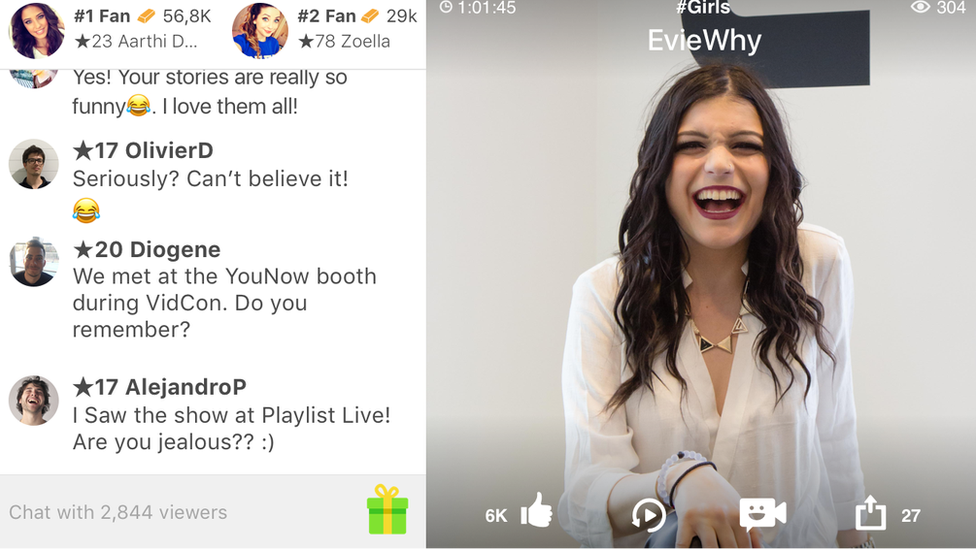Is live streaming your life good business or dangerous?
- Published

Samantha Firth has attracted 350,000 fans on live streaming site Live.me
Live streaming is becoming big business, with millions of people around the world broadcasting the minutiae of their daily lives in real time to adoring fans - and making small fortunes in the process. But is it safe?
Samantha Firth, a 21-year-old nanny living in Chicago, walks to the subway with her friend. So far, so ordinary.
But she is simultaneously broadcasting her 15-minute journey live via her mobile to thousands of avid followers.
"You guys are lit," she says excitedly as she looks at the stream of rolling messages and emojis that are popping up on her screen from her fans.
"I love you... you guys are the best," she exclaims, before heading onto the subway and zooming the camera in on a spot on her forehead.
It used to be that only film stars would be famous, but thanks to reality TV, YouTube and bloggers, anyone can have their "fifteen minutes" of fame, as Andy Warhol predicted.
The proliferation of live broadcasting tools, pioneered by Meerkat several years ago and followed by the likes of Periscope, Facebook, YouTube and others, has given many young people the chance to broadcast every aspect of their lives - whether they're brushing their hair in their bedroom or out dancing with friends.
In China alone, the entertainment live streaming market is valued at £5bn, according to Credit Suisse.
And in the US, 63% of 18-34 year-olds are watching live content and 42% creating it, finds a study by UBS Evidence Lab.

Big business: Live.me recently raised $60m from investors
But for many like Ms Firth, this isn't just narcissistic fun, it's a cash cow.
She joined Live.me - owned by China's Cheetah Mobile - eight months ago after moving from Sydney to Chicago. The live-in nanny has since become one of the most popular broadcasters on the site, amassing 350,000 fans.
These devotees bombard her with virtual gifts - animated stickers that can be converted into "diamonds" and then real money - helping her pull in about $21,000 (£16,300) a month.
"Coming from a different country it has been difficult to make friends, but this app has allowed me to connect with people who have the same interests," she says of her reasons for joining.
"I spend most of my free time broadcasting because it's where most of my friends are."
She is keen to portray a candid version of herself, pimples and all.
"I don't wear make-up, I wear sweatshirts and sweatpants," she says. "Sometimes I cry when someone says something hurtful on a broadcast."
Like Live.me, live streaming platform YouNow enables these citizen broadcasters to make money from fans sending them virtual gifts. Fans of some streaming sites can also subscribe monthly to their favourite live streamers.

Emma McGann thinks her live broadcasts have helped boost her music career
It's been a real moneyspinner for the top broadcasters, who can earn up to $200,000 (£155,000) a year.
Singer Emma McGann, 26, broadcasts live from her studio in Coventry, England, for three to six hours every day. She says her live streams attract about 5-10,000 unique views.
YouNow not only provides her with a good salary - she earns £2,000-3,000 a month via the channel - but it has helped her gain exposure for her music.
"It enabled me to get a single in the iTunes chart," she says. "It's also a great testing ground for new material."
"I like the live element. I like to interact with the audience and take song requests."
Fans can also speak to her over the internet.
While many brands are already running their own live streaming sessions, We Are Social head of strategy Harvey Cossell believes there are opportunities for brands to capitalise on live streaming by co-creating with individuals who have already amassed a loyal audience.
The success of such collaborations in the social gaming world, on sites such as Twitch, are a case in point.
"They would need to identify those people that represent a similar set of values to the brand in question and then find creative ways to partner with them in the production of their content," he advises.
The challenge, he warns, is one of authenticity.
"It's always better for brands either to partner with the right person, or do nothing at all."

Live streaming site YouNow has 34 million registered users
Some researchers are forecasting, external that the live streaming business will be worth $70bn globally by 2021.
But for all its engagement value and monetisation potential, you only have to search online to see that live streaming has its dark side.
Earlier this year, 12-year-old Katelyn Nicole Davis took her own life and broadcast it live on Live.me, while there have been many reports about paedophiles watching live streaming of child sex abuse.
"Live streaming apps and sites can expose young people to graphic and distressing content and can leave them vulnerable to bullying and online harassment," an NSPCC [National Society for the Prevention of Cruelty to Children] spokesman tells the BBC.
"Worryingly, live chat can also be used by groomers to target young people who may be manipulated into sending sexual images and videos."
Khudor Annous, head of marketing and partnerships at Live.me, says the company has a number of safeguards, including a facial recognition tool that can supposedly spot anyone who's under the age of 13 on the app.
"If they are in fact under the age of 13, then we ban the account," says Mr Annous.
"We have also provided users with reporting tools to report a channel if they identify a child in the app. We're typically able to evaluate reports within a couple of hours depending on daily volume."
As for grooming, he says: "Every user has the ability to report any suspicious behaviour before, or any violations of our community guidelines. We also work with the FBI and local law enforcement agencies around the globe to ensure the safety of our community."
But there are also concerns that the broadcasters are themselves exploiting young people.
Clinical psychologist Linda Blair describes the rise of young people live streaming as "very sad".
She adds: "It's an indication of loneliness. They might temporarily feel great but it's only a distraction."
But with millions of people already using live streaming platforms, including Facebook Live, we can expect the number of everyday broadcasters to continue growing.
"I see live streaming following a path similar to social networking, where at first it started as a place for people to connect with each other but eventually evolved into a powerful platform for advertising, marketing, and publishing," says Paul Verna, principal analyst at eMarketer.
Mr Cossell also believes that live video will expand into other formats.
"It will begin to harness emerging technologies such as 360-video and virtual reality more readily," he says.
"Live streaming is clearly here to stay."
Follow Technology of Business editor Matthew Wall on Twitter, external and Facebook, external